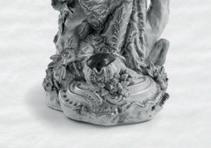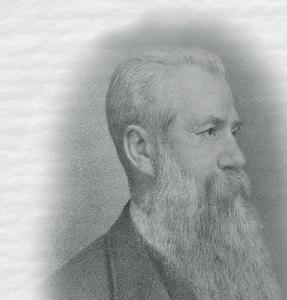
6 minute read
A Cradle of Enlightenment How the foremost thinkers, philosophers, inventers, entrepreneurs and playwrights of Devon contributed to the remarkable Age of Reason
Sir Joshua Reynolds
Devon
Advertisement

a cradle of enlightenment

Amid giants of the Enlightenment from Hobbes, Hume and Handel to Rousseau, Franklin and Voltaire, we look at four Devon-born characters who made a signifi cant contribution to a wonderful age of innovation and change.


William Bickford
William Cookworthy




Hand held touch screen technology, 3D printers, driverless longer necessary to import porcelain from China and welcomed vehicles, the internet of things - all mind-boggling in a new age of ceramic design and production to England. achievements but today’s inventors and entrepreneurs are Born into a Quaker family in Kingsbridge, South Devon, supported by pretty full toolboxes with untold accumulated Cookworthy had a hard start to life. His father died when he was knowledge and skillsets, big data analysis and artifi cial just 13 and the family were fi nancially ruined by the South Sea intelligence to help them. We are no longer that surprised with Bubble aff air. Young William had no choice but to walk the 200 every new technological advance. miles to London to take up a pharmacy apprenticeship off ered
By contrast, the Age of Reason, that remarkable chapter to him by fellow Quakers. in history from the late 17th to the early 19th century, Many years later he returned to Devon, becoming a partner fundamentally changed the way people thought, changed in a pharmacy business in Notte Street, Plymouth and a custom and tradition, challenged religious orthodoxy and respected elder of the Society of Friends. He was also a friend political authority, ushering in the industrial revolution and political authority, ushering in the industrial revolution and of lighthouse builder John Smeaton (his Eddystone Lighthouse of lighthouse builder John Smeaton (his Eddystone Lighthouse what we now think of as the what we now think of as the now adorns Plymouth Hoe) now adorns Plymouth Hoe) modern world. and hosted visits by Captain and hosted visits by Captain
The Age of Enlightenment The Age of Enlightenment Hannah James Cook. James Cook. had its own society-changing had its own society-changing Cowley As well as scientists scientifi c discoveries and scientifi c discoveries and and artists, the Age of and artists, the Age of inventions, new attitudes inventions, new attitudes Enlightenment is also full of Enlightenment is also full of to commerce and great literary fi gures, but few great literary fi gures, but few entrepreneurship, fresh entrepreneurship, fresh would realise just how many would realise just how many philosophical ways of thinking philosophical ways of thinking scores of female playwrights scores of female playwrights that suggested everything that suggested everything were working at the time. were working at the time. is capable of rational Among the foremost was explanation, an explosion in explanation, an explosion in Tiverton-born Hannah Cowley Tiverton-born Hannah Cowley the arts and literature and a the arts and literature and a (1743-1809). She was inspired (1743-1809). She was inspired quest for freedom that led to quest for freedom that led to to write after attending a play to write after attending a play more self-determination and more self-determination and and realising she could do and realising she could do revolutionary fervour. From revolutionary fervour. From better, writing the fi rst act better, writing the fi rst act today’s perspective it all may today’s perspective it all may overnight to prove to her overnight to prove to her seem slow in its development seem slow in its development husband she could do it. husband she could do it. but then, it must have been but then, it must have been Cowley enjoyed early breath-taking. success with a play entitled success with a play entitled
One benefi ciary of the One benefi ciary of the ‘The Runaway’ which was ‘The Runaway’ which was reawakened interest in art reawakened interest in art produced by David Garrick in produced by David Garrick in prompted by the fashion of prompted by the fashion of 1776. It showed early promise 1776. It showed early promise ‘the Grand Tour’ was Plymouth ‘the Grand Tour’ was Plymouth of sharp and witty dialogue of sharp and witty dialogue born Sir Joshua Reynolds (1723-1792). Educated at born Sir Joshua Reynolds (1723-1792). Educated at “ As well as scientists and artists, the As well as scientists and artists, the in romantic comedies with an underlying feminist in romantic comedies with an underlying feminist Plympton Grammar School, Plympton Grammar School, Age of Enlightenment is also full of great Age of Enlightenment is also full of great message that women are message that women are the young Joshua was apprenticed to portraitist the young Joshua was literary fi gures, but few would realise just the equal of men and should be treated as such both on the equal of men and should Thomas Hudson in London. how many scores of female playwrights and off the stage. She was, He frequently returned to indeed a visionary for her Devon including a spell as a were working at the time ” time. In her plays, women portrait-painter in Plymouth took centre stage. No better Dock gradually refi ning his skill is this illustrated than when before he took his own grand tour of Europe. Taking in Florence, one of her characters in the 1780 play, ‘The Belle’s Stratagem’ Venice and Rome, he was greatly infl uenced by studying the proclaims: “All I know is whatever we do - it must be twice great masterpieces of Italian sculpture and painting. as well as men to be thought half as good. Luckily that’s not
In 1753, Reynolds moved permanently to London where his diffi cult.” Written over 240 years ago – that’s some vision!. reputation as a portraitist grew. He was also popular in society and Many, many lives of miners, especially Cornish tin miners, were mixed with some of the great fi gures of the day such as James saved by a simple invention of an Ashburton born man. William Boswell, Samuel Johnson, Edmund Burke and Oliver Goldsmith. Bickford (1774-1834) invented a fuse that could safely ignite
In 1768, Reynolds was one of the founders of the Royal gunpowder underground with a reliability that gave those that Academy becoming its fi rst president and receiving a set the charges time to get clear. knighthood. Among many self-portraits and enchanting studies Having moved to Tuckingmill near Camborne to pursue of children, his subjects comprised some of the great fi gures his business as a leather merchant, Bickford is said to in society including Horace Walpole, Samuel Johnson and have observed a friend making a rope and realised that, Laurence Sterne. Reynolds died in 1792 and was buried in St. by winding rope around a central core of gunpowder, Paul‘s Cathedral. waterproofi ng it and cutting it to the required length, it
The world of ceramics was to change forever when William became possible to control the delay on the fuse. It would Cookworthy (1705-1780) discovered how to make hard-paste normally take just a couple of feet of the safety fuse to porcelain using the only English source of China clay to be ignite a gunpowder charge, but in its fi rst year of production found near St. Austell. Obtaining a patent in 1768, it was no Bickford manufactured 45 miles of it!

















